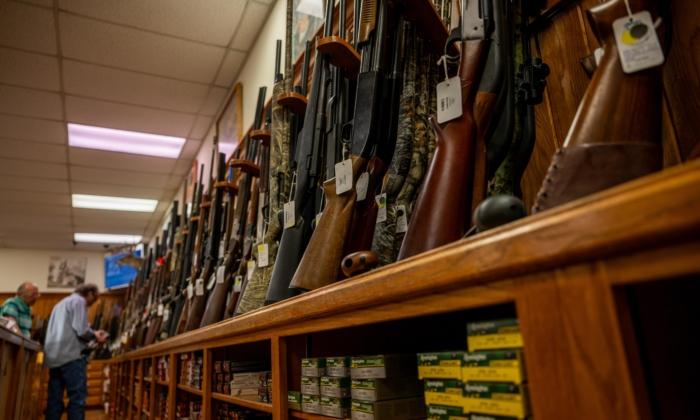Months after a federal judge declared Oregon’s new gun control measure constitutional, the fate of the law could soon be decided in a state court.
The trial for Measure 114 began on Sept. 18 in Harney County. Presiding Circuit Judge Robert S. Raschio scheduled six days for arguments on whether the law violates the Oregon Constitution.
Voters approved the measure last year with 50.7 percent of Oregonians saying “yes.”
The measure requires Oregonians to undergo a background check and take a firearms class, which does not yet exist, to obtain a permit to purchase a firearm.
It also bans magazines that are capable of holding or being modified to hold more than 10 rounds.
Gun rights advocates have called it one of the most extreme gun laws in the country, claiming that it will strip law-abiding citizens of their constitutional right to bear arms in the state.
Initially set to go into effect on Dec. 8, 2022, the measure has been on hold since Judge Raschio issued a preliminary injunction allowing parties to argue its legality in federal and state court.
A federal suit has already been argued in a U.S. District Court.
After a weeklong trial in July, federal Judge Karin Immergut ruled the entire measure is constitutional.
She specifically found the large capacity magazine ban and permit requirement were consistent with other regulations of weapons and would be allowed under prior U.S. Supreme Court decisions.
In August, plaintiffs in that case filed an appeal in the Ninth Circuit Court of Appeals. This could move the decision to the U.S. Supreme Court.
Limiting the Scope
In a Sept. 14 pre-trial hearing, Judge Raschio narrowed the scope of the state trial.The judge granted the plaintiffs’ motion to bar certain testimony, including testimony about gun violence, the number of rounds fired in self-defense situations, and about treating gunshot victims.
He also granted the defendant’s motion to exclude testimony relating to state and local efforts and ability to implement the measure.
“The question is whether or not Measure 114 is facially constitutional under the Oregon Constitution. So all of that evidence is outside the scope of the court’s purview since I’m not making a policy decision,” Judge Raschio explained.
“I’m just making a determination on the constitutionality of the ballot measure.”
David v. Goliath
Two small-town attorneys are representing the plaintiffs, private gun owners Joseph Arnold and Cliff Asmussen. Each has bought or owns dozens of firearms and magazines for self-defense, or to control pests and predators on their rural properties.The defense team includes nine attorneys representing the State of Oregon, specifically Gov. Tina Kotek and Attorney General Ellen Rosenblum.
“This case is not about public health, safety or concerns,” argued plaintiffs’ attorney Tony Aiello, Jr. in his opening statement.
“It’s about the individual right to self-defense and how that right will fare against the might of the state government.”
“For the first time in our history, you will need a ‘permission slip’ from the government before you can purchase a gun,” he continued.
The permit to purchase program would require buyers to “submit to fingerprint and background checks” that the FBI has said it will not provide, making it impossible to qualify, he explained. It also “creates a gun registry.”
Mr. Aiello argued the measure’s language will outlaw virtually all firearm magazines because they are “capable of being modified” to hold more than 10 rounds.
He described the measure as “the greatest threat to the right to bear arms in the state since its founding in 1859.”
Anit Jindal, one of the state defense attorneys, argued that: “Measure 114 is a reasonable legislative response to the public safety concerns posed by firearms.”
“Large capacity magazines were not in common use for self-defense in the 1850s,” when the state constitution was drafted, Mr. Jindal continued.
“Modern firearms bearing large capacity magazines do not have any relevant 1850 counterparts and are rarely used in self-defense” and “the permit to purchase program is a reasonable public safety measure and is consistent with the historic exercise of the right to bear arms,” Mr. Jindal added.
Following the opening arguments, plaintiffs began to call witnesses.
Plaintiffs Witnesses
Mr. LeBlanc testified to the number of rounds he recommends his clients carry for self-defense as well as statistics about reload times for a firearm magazine.
Under cross-examination, defense attorneys challenged Mr. LeBlanc’s status as an independent expert witness, claiming instead that he is a firearms advocate who had been coached by Mr. Aiello.To support that claim, the defense showed Mr. LeBlanc’s blog posts during the federal trial in which he claimed he was helping the attorneys.
Defense attorneys also presented an email exchange showing that Mr. Aiello has provided the questions he would ask at trial as well the “answers he hoped to hear.”
The trial was repeatedly delayed so plaintiffs’ attorneys could respond to defense challenges.
Ms. Hlebinsky then testified to the long history of firearms, including those capable of firing multiple rounds.
A firearms historian and curator for the Smithsonian Institution and the Cody Firearms Museum in Wyoming, Ms. Hlebinsky manages a collection of more than 7,000 firearms dating from the 1200s to the modern day. She also co-founded and is a senior fellow for the University of Wyoming College of Law’s Firearms Research Center.
Since the U.S. Supreme Court struck down a New York firearm restriction in 2022, the state must show that its regulations are historically consistent. It aimed to prove that semiautomatic firearms were not “common” when Oregon adopted its constitution in 1859.
Ms. Hlebinsky testified that: “Gunmakers began to market and advertise multi-shot guns in the 1700s.”
The defense objected to her qualifications as a historian, claiming she does not possess a doctorate degree as such.
“She has not established a period of research and study in the history and prevalence of firearms back to the 1850s,” the defense argued.
The defense said this opinion was in line with Judge Immergut’s ruling in the federal case that Ms. Hlebinsky was not a historian and was not a qualified expert witness.
Judge Raschio disagreed.
He found that Ms. Hlebinsky “has sufficient education around firearms through her work in the field” to be considered comparable to a bachelor’s or master’s degree and “she meets the qualifications as an expert in firearms.”
“If Ms. Hlebinsky is good enough for the Smithsonian and the museum in Wyoming, she’s good enough for this court,” he said.
The plaintiffs initially planned to finish presenting their case in two days. Defense attorneys said they need just two days as well.
Based on the number of objections on the first day of the trial, those plans could very well change.
Should the state court declare the measure unconstitutional, the Oregon Department of Justice has indicated that it will appeal the decision.







